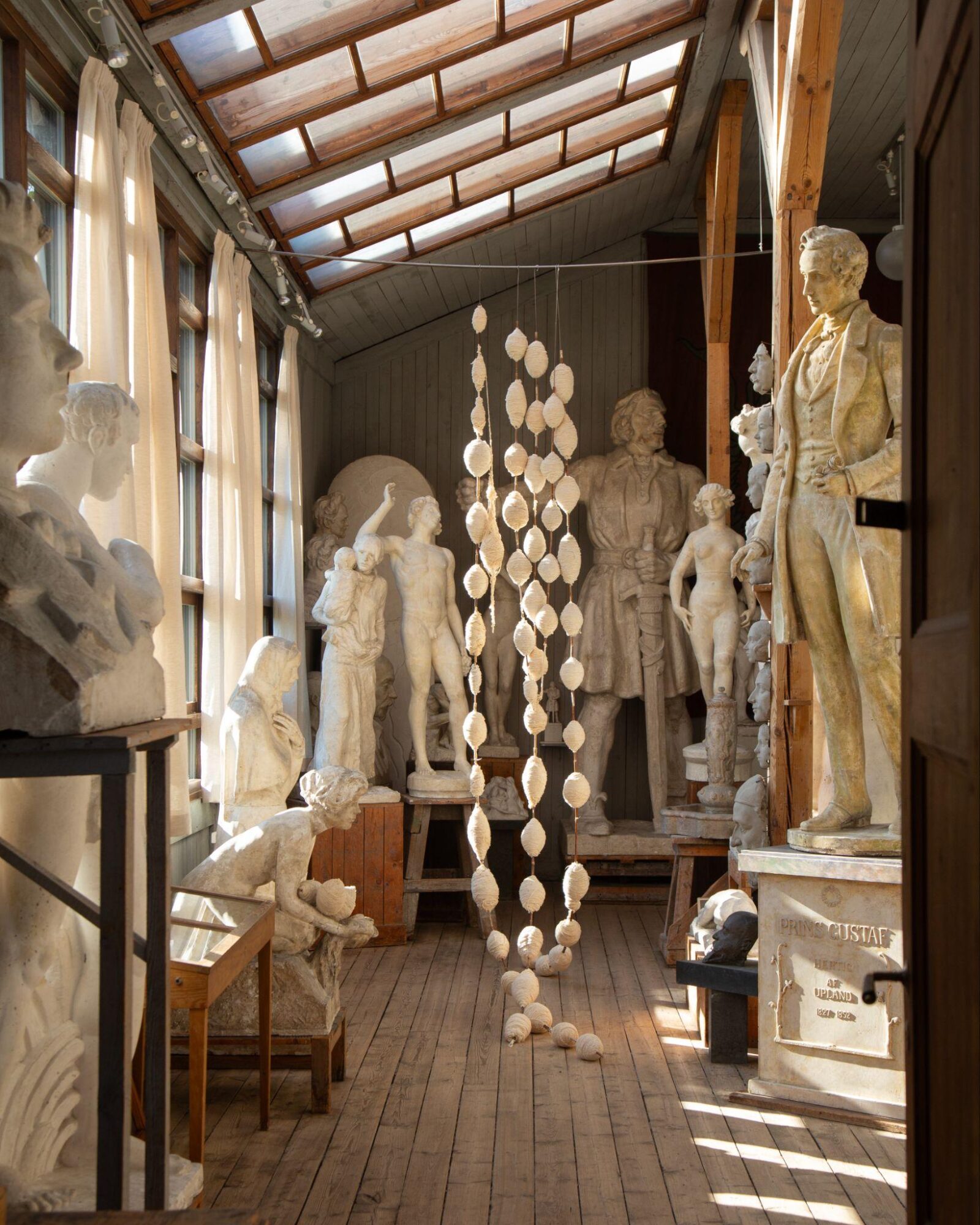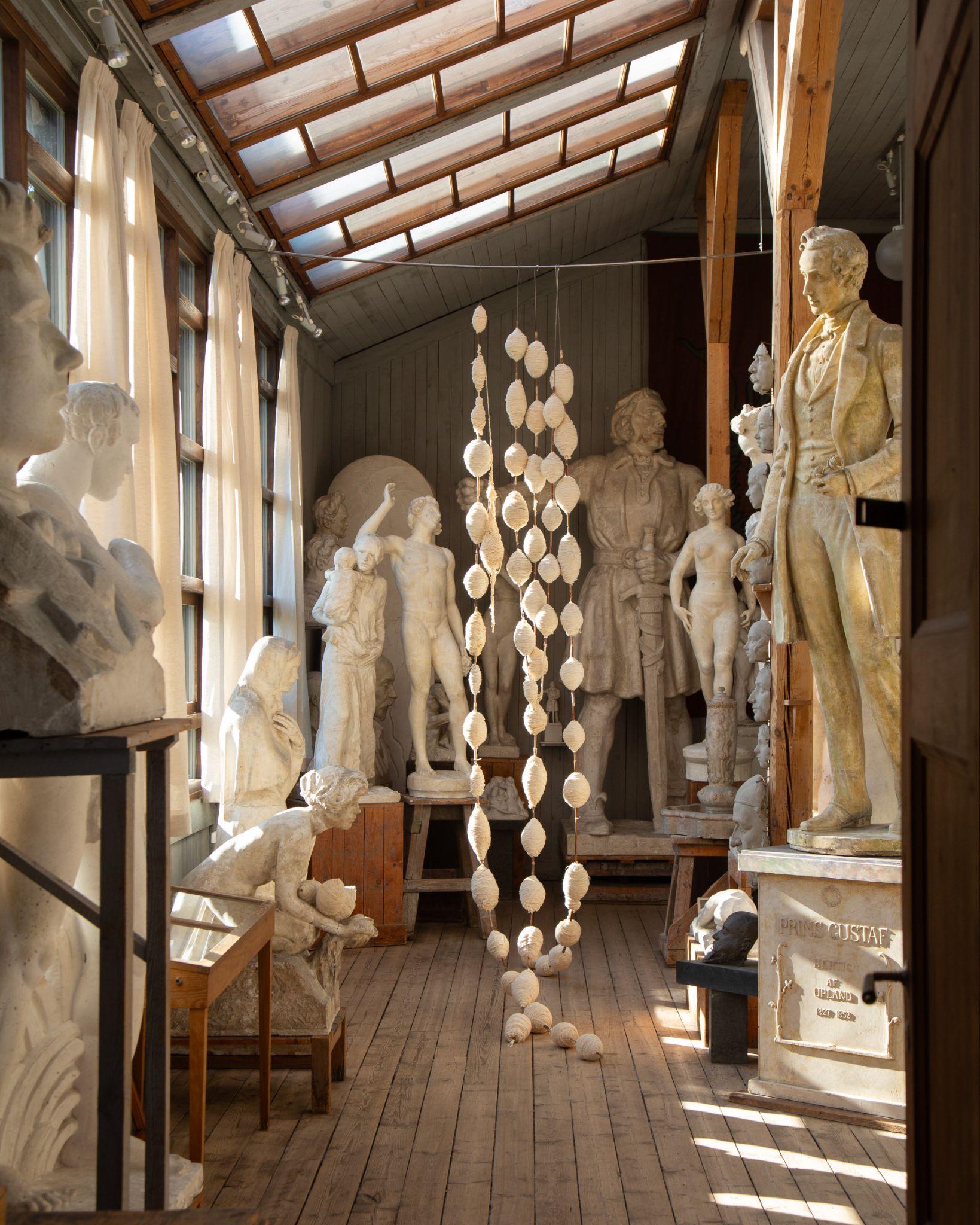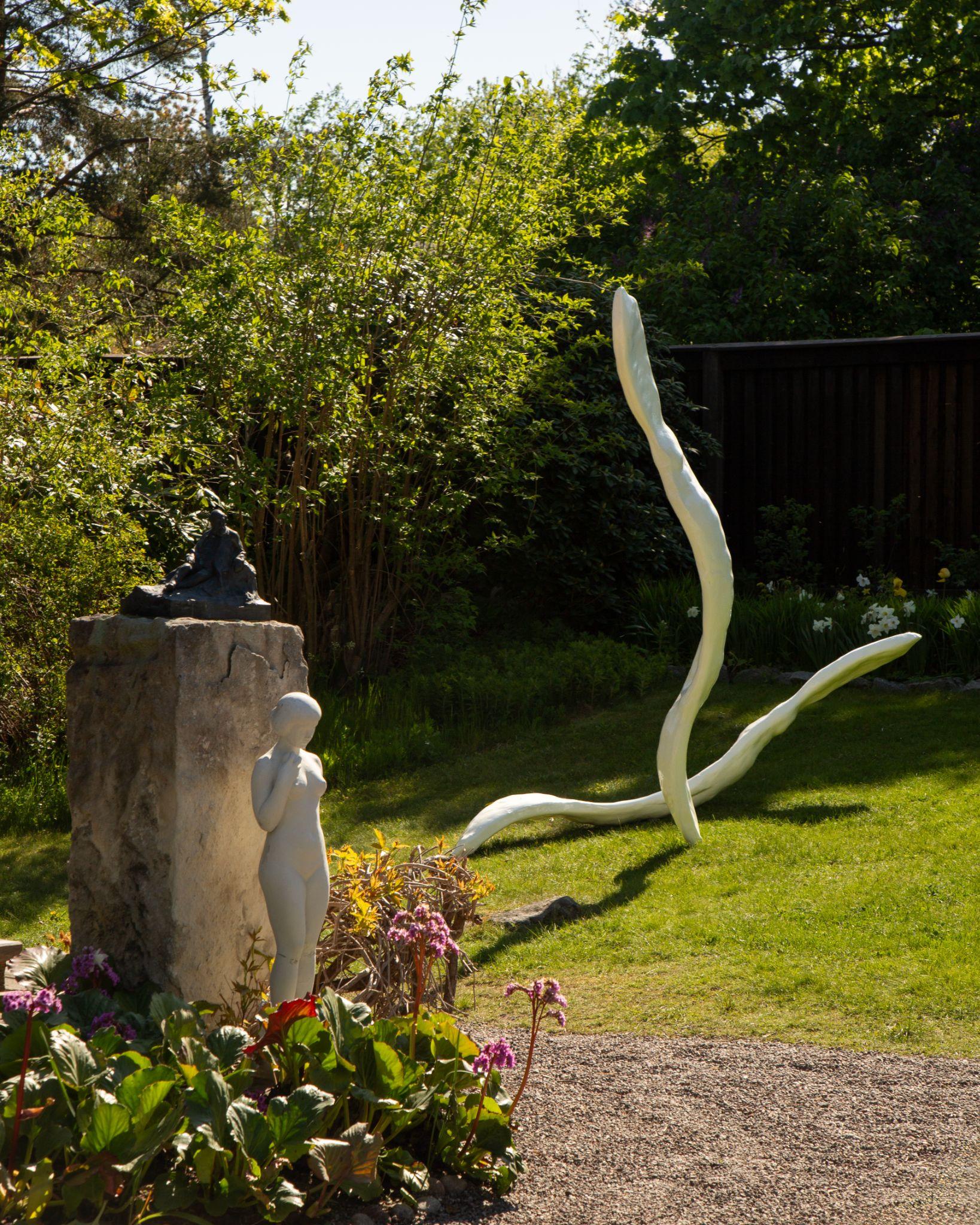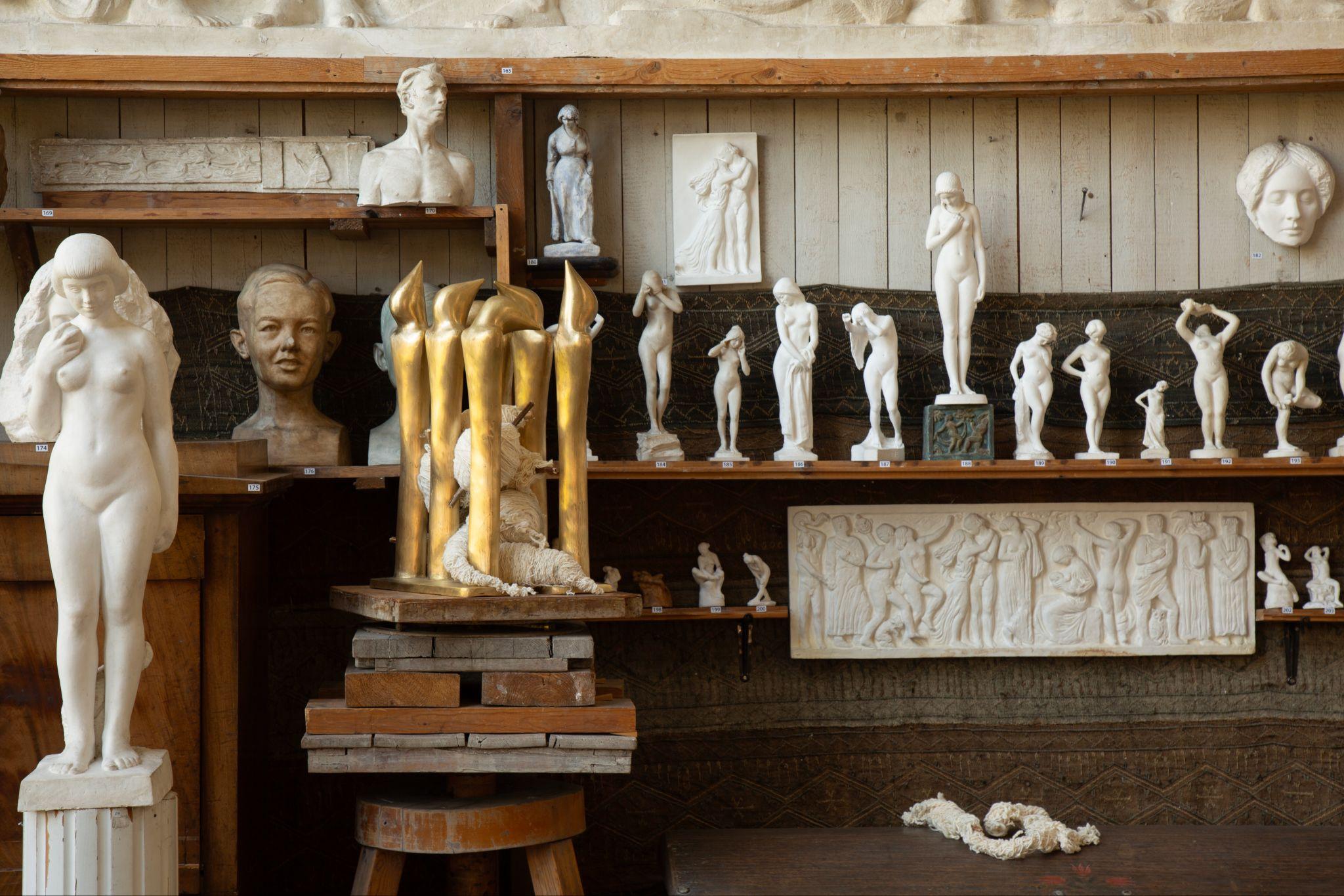Family Threads the Speaking Gaze as Theresa Traore Dahlberg Recasts Portraiture in a Sculptor’s Museum


Rising to prominence in the early 20th century, Swedish sculptor Carl Eldh’s career is marked by the people he sculpted as monuments and private commissions. The playwright August Strindberg, known for his psychological realism, was a friend and frequent subject, a rival of Norwegian playwright Henrik Ibsen. They both wrote influential plays on gender; Ibsen’s A Doll’s House delves into societal constraints, while Strindberg’s Miss Julie tackles class conflict and the destructive aspects of desire and ambition. Eldh also sculpted the bronze relief monument of the Social Democratic leader Hjalmar Branting, in which he addresses a group of workers on a May Day demonstration. A visit to Eldh’s studio museum in Stockholm offers historical snapshots of these and many other contemporaries through more than 500 plaster sketches, models, and sculptures in bronze, stone, and clay.
But, visiting artist Theresa Traore Dahlberg is less concerned with these grand narratives; rather, she wants to shed light on what they miss. In an exhibition within the exhibition (each summer, the museum showcases a new contemporary artist) Traore Dahlberg’s carefully placed bronze, yarn, painting, and video works make visible the lives of women while begging visitors to ponder how and what a portrait might narrate, and what it cannot.


In 1963, Carl’s daughter Brita Eld turned the studio into a foundation and opened it as a museum to the public—she was involved with the museum and lived on-site until the late 1990s, when she moved into an elderly care home due to poor health. Despite her pivotal role in the museum’s founding, her life remains underresearched. As Traore Dahlberg’s intervention lifts, Brita and her mother, Elise, spent much time away from Carl in the greater Los Angeles area. The family moved there in 1907, intending to introduce Carl to the U.S. market, but he soon returned to Sweden and continued to support his wife and daughters’ life abroad for the next thirty years. Held at the museum, much of Eldh’s archive remains unstudied, and the details of Brita and Elise’s U.S. life remain undiscovered. Traore Dahlberg’s work scratches the surface.
Centering this showcase is a two-channel video work where Traore Dahlberg has juxtaposed Super 8 video footage from the 1950s that centers Brita and Elise in the manicured garden of their Alhambra house, screened in a room adjacent to the main studio. Brita is dressed in various period costumes and cosplays—is she preparing for auditions? Hollywood was close by. Or, is it a playful game of dress up? We don’t know. The video snippets also portray the two women gardening, interspersed with footage of Alhambra’s impressive natural backdrop, as seen from their house, and a curling rattlesnake. Traore Dahlberg’s cuts evoke the Garden of Eden, pleasant, fun, and bountiful; her inclusion of a rattlesnake opens the door to something darker that may lie beneath the surface. It’s giving Grey Gardens, hard to determine what is real and fantasy. As the studio museum’s sculpture garden is one of its important features, the artist’s choice to present footage of Brita and Elise in their garden frames them as sort of living sculptures. With an air of mystery, Traore Dahlberg, a trained documentarian filmmaker, poetically aggrandizes the lives of these women, shedding light on the fact that a portrait (sculpture and video alike) cannot present a full picture. Provoking further contemplation of what is left out of the many portraits in the adjacent rooms.

Dahlberg brings traces of her paternal grandmother, father, and son into her presentation. Outside, in the garden, there is a sculpture titled after her son, Osvald. Inside, on the lap of Maya, a plaster sculpture of a fifteen-year-old girl, Traore Dahlberg has placed a leaf picked by Osvald. Is she a stand-in for Carl’s daughter, whose teenage years he missed? Or does her son simply identify with this sculpture of a young girl, being a child himself? A video piece shot on the island of Öland, where the artist summers and partially grew up, depicts her son and father playing with steel plates used for SIM card production. Together, they line them up on the grass—on the screen where colors are washed out using an archival type filter. Hailing from Burkina Faso, Traore senior spends most of his time there, while his grandson lives in Sweden. Their meeting holds layers of distance and intimacy foregrounded by a technology that plays a large role in connecting people across geographic distance. As a child, Traore Dahlberg and her family shuttled between Sweden and Burkina Faso, so living with separation is a topic that is close at hand. Perhaps that’s why her video of Brita and Elise holds both joy and uncertainty.

Other pieces are Traore Dahlberg’s yarn works that make visible outcast women in Burkina Faso who work with spinning, hanging from the ceiling, or draped within her bronze sculptures, as in the work poetically titled Dolda Sagor, or Hidden Stories. These women have been accused of witchcraft and have banded together to earn their living. In Sweden, there is a 19th-century equivalent—prostitutes worked in spinning houses. Traore Dahlberg connects these two groups of women who were and are deeply embedded within certain parts of society, but cast out from others. Bronze hares with elongated ears and a series of paintings of a hare are also installed throughout the studio. Traore Dahlberg uses the hare to question museological and collecting practices. Based on a sculpture of a hare accessioned to the Museum of Etnography in the 1930s, the series explores how decolonial practices might erase colonial narratives, and was first on view at the museum. Adding a personal layer to her research, the sculpture was from her paternal grandmother’s village in Burkina Faso. Begging the question, who has the right to tell another’s story, and when is it time to try?
You Might Also Like
‘Beauty Can Be Immaterial:’ Bianca Abdi-Boragi on Her Sculptures That Investigate Time
What's Your Reaction?
Anna Mikaela Ekstrand is editor-in-chief and founder of Cultbytes. She mediates art through writing, curating, and lecturing. Her latest books are Assuming Asymmetries: Conversations on Curating Public Art Projects of the 1980s and 1990s and Curating Beyond the Mainstream. Send your inquiries, tips, and pitches to info@cultbytes.com.

